Foreword xi
Preface xiii
Part I
Evaluation and Preparation 1
Chapter 1
Patient Se lection 3
Maria M. Aaron, MD
Criteria for Surgical Intervention 3
Factors That Affect Surgical Risk 4
Ethical Considerations 7
Implications of the Surgeon’s
Experience 8
Chapter 2
Preparation of the Patient 11
Rebecca D. Sarran, MD
Hreem Patel, MD
Jack A. Cohen, MD
Preparations in the Office 11
Pro cess in the Operating Room 13
Chapter 3
Preparation of the Surgeon 17
Alla Goldberg, MD
Eric R. Holz, MD
Familiarization 17
Understanding the Planned Procedure 18
Knowing the Tools 18
Physical Factors That Affect the
Surgeon 18
Hand Preparation 20
Operating Room Environment 21
Chapter 4
Informed Consent 25
Kian Eftekhari, MD
Paul J. Tapino, MD
Importance of Informed Consent 25
Ele ments of Informed Consent 26
Obtaining Informed Consent:
Challenges for Residents 27
Summary 31
Chapter 5
Simulation in Surgical Training 35
William G. Gensheimer, MD
Yousuf M. Khalifa, MD
Wet Laboratory 35
Intraocular Simulation 36
Virtual Real ity 40
Part II
Surgical Logistics 43
Chapter 6
The Importance of Ergonomics for
Ophthalmologists 45
Sandra M. Woolley, PhD
Anna S. Kitzmann, MD
Ergonomics and Ergonomic Risk
Factors 45
Adopting Ergonomically Friendly
Practices 46
Reducing the Risk of Developing
Musculoskeletal Disorders 59
Chapter 7
The Operating Microscope and
Surgical Loupes 63
Norman A. Zabriskie, MD
Daniel I. Bettis, MD
Advantages and Disadvantages of
Magnification 63
Patient Positioning 64
Surgeon Positioning 68
Positioning the Bed 70
Stabilizing the Hands 71
Microscope Function 76
Surgical Loupes 80
Chapter 8
Surgical Instruments and
Blades 85
Robert B. Dinn, MD
Jay M. Lustbader, MD
Surgical Instruments 85
Other Specialized Surgical
Instruments 104
Surgical Blades 106
Chapter 9
Suture Materials and Needles 111
Jennifer Lee, MD
Keith D. Car ter, MD
Characteristics of Sutures 111
Classification of Sutures 111
Needles 115
Chapter 10
Lasers 119
Neeti Parikh, MD
Jonathan D. Walker, MD
Laser Physics 119
Laser– Tissue Interactions 120
Wavelength 123
Controlling the Energy 124
Putting the Variables Together 125
Laser Safety 127
Patient Issues 128
New Directions 129
Chapter 11
ACGME Requirements for Surgical
Training 133
Bryan J. Winn, MD
ACGME Case Logs 133
Common Pitfalls 135
Tips for Maintaining an Accurate Surgical
Log 136
Beyond Residency and the ACGME 137
Milestones 137
Part III
Intraoperative Considerations 141
Chapter 12
Aseptic Technique and the Sterile
Field in the Operating Room 143
Ensa K. Pillow, MD
John Russell Burks, MD
Skin Preparation 143
Application of Antiseptic Agents 144
Hand Scrubbing 144
Gowning and Gloving 147
Draping 148
Sterile Field 148
Chapter 13
Ophthalmic Anesthesia 153
Steven J. Gedde, MD
Yunhee Lee, MD, MPH
Sedation 153
Local Anesthetic Agents 154
Regional Anesthetic Agents 155
Local Anesthesia 157
Regional Anesthesia 158
General Anesthesia 163
Facial Nerve Blocks 164
Complications of Ophthalmic
Anesthesia 165
Chapter 14
Hemostasis 171
J. Paul Dieckert, MD, MBA
Prevention 171
Heating 171
Vasoconstriction 173
Biochemical Enhancement of
Hemostasis 173
Mechanical Tamponade 174
Embolization 174
Chapter 15
Suturing and Knot Tying 177
Edward J. Wladis, MD
Paul D. Langer, MD
Simple Square Knot 177
Basic Suturing Princi ples 179
Common Suturing Techniques 180
Chapter 16
Intraocular Fluids 187
James P. Dunn, MD
Ophthalmic Viscosurgical
Devices 187
Irrigating Fluids 191
Mydriatics and Miotics 192
Anesthetics 193
Corticosteroids, Antibiotics, and
Antifungals 194
Capsular Staining Agents 195
Vascular Endothelial Growth Factor
Antagonists 195
Compounding Intraocular
Drugs 196
Chapter 17
Patient Safety Issues 199
Andrew G. Lee, MD
Claudia M. Prospero Ponce, MD
Infection Prophylaxis 199
Surgery on the Incorrect
Eye 199
Incorrect Intraocular Lens
Insertion 202
Minimizing Medi cation Errors:
Communication About Drug
Orders 202
Preventing Surgeon- Related Fire in the
Operating Room 205
Part IV
Postoperative Considerations 213
Chapter 18
Postoperative Management 215
Dmitry Pyatetsky, MD
Nicholas J. Volpe, MD
Postoperative Instructions 215
Timing of Postoperative Care 217
Transition of Care 219
Focus of the Examination 220
Pain Management 221
Management of Complications 222
Chapter 19
The Healing Pro cess 229
Casey Mickler, MD
Frank Moya, MD
Peter A. Quiros, MD
Healing by Intention 229
The Pro cess of Healing 230
Wound Healing in Dermal/Conjunctival
Tissue 233
Corneal Wound Healing 236
Scleral Wound Healing 239
Uveal Wound Healing 240
Modifying Wound Healing 240
Wound Healing Enhancers 242
The Ultimate Goal 243
Chapter 20
Dressings 247
David K. Wallace, MD, MPH
Shaohui Liu, MD, PhD
Advantages and Disadvantages of
Postoperative Dressings 247
Indications 248
Supplies 248
Technique for Dressing Placement 250
Postoperative Instructions 252
Dressing Removal 253
Chapter 21
Handling of Ocular Tissues for
Pathology 255
Mahendra K. Rupani, MD
Christa Soekamto, MD
Anvesh C. Reddy, MD
Preoperative Planning, Cryosection,
and Routine Handling of
Specimens 255
Supplies and Equipment,
Requisitions 256
Labeling of Specimen Containers 258
Specimen Requisitions 258
Transportation 259
Frozen Sections 259
Pearls for Handling of Routine
Specimens 261
Special Procedures 265
Gross Specimens Only 266
Chapter 22
Complications and Their
Consequences 269
Sarah W. DeParis, MD
M. Reza Vagefi, MD
Care of the Patient 269
Medicolegal Implications of an
Error 271
Care of the Surgeon in the Event of an
Error 273
Appendix A
Preferred Responses, Chapter
Self- Assessment Tests 277
Index 279
Basic Principles of Ophthalmic Surgery 4th Edition PDF Ebook



